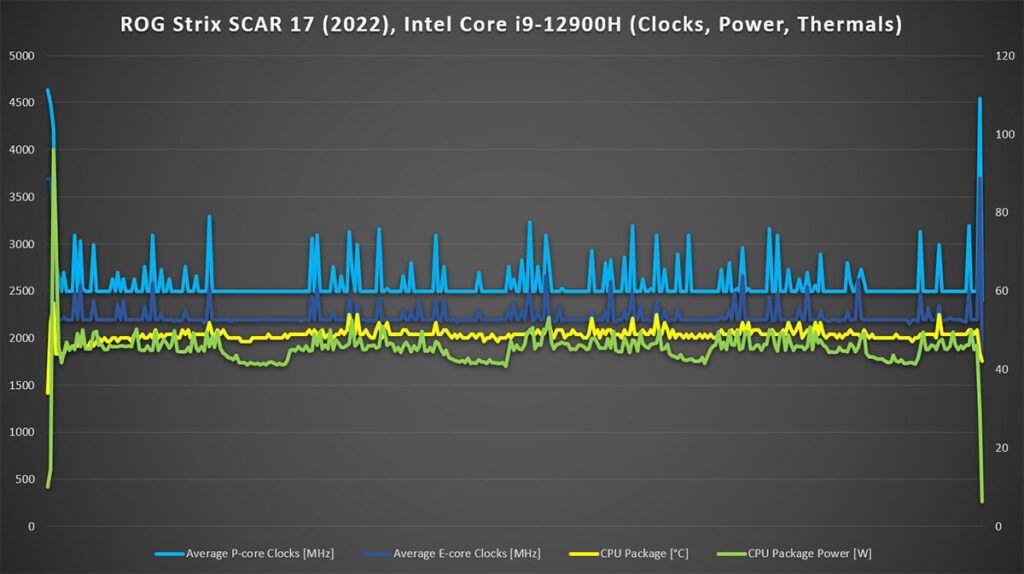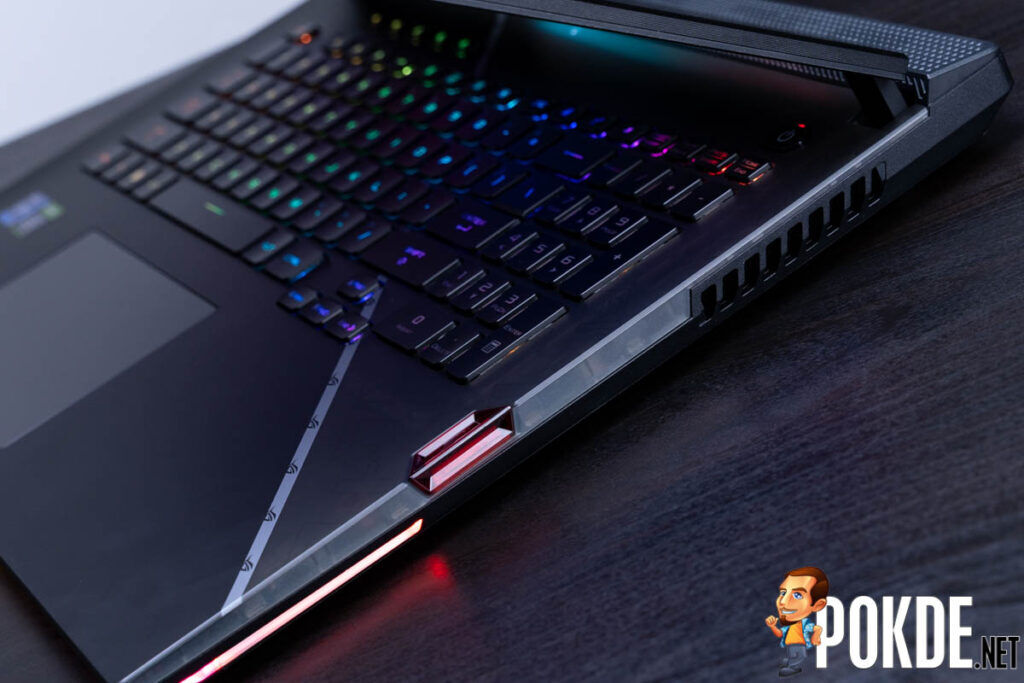12th Gen Intel Core i9-12900H Review ft. ROG Strix SCAR 17 (2022) — making the “desktop replacement laptop” a reality
We don’t usually do laptop CPU benchmarking or reviews, but this time it seems like it’s interesting enough to warrant some additional testing. We got the ROG Strix SCAR 17 (2022) in for review, and under the hood is the powerful 12th Gen Intel Core i9-12900H. Unless you want to manually overclock — for which you will have to look towards the Core i9-12900HK — this is about the fastest 12th Gen Intel Core laptop processor you can get, and man is it fast. But before we get into that, here’s a quick recap of the latest Alder Lake-based mobile processors.
12th Gen Intel Core H-series processors
The 12th Gen Intel Core processors definitely shook up the x86 processor space, with an all-new hybrid architecture comprising of Performance cores and Efficient cores, DDR5 memory support and PCIe 5.0 capabilities. After several years of being somewhat idle when it comes to innovation, this was truly a breath of fresh air. Then we have the 12th Gen Intel Core laptop processors, which are quite different beasts compared to their desktop counterparts.
For starters, Intel is now cramming everything onto a single package, with the chipset sharing the same package as the processor itself. You also get much larger integrated graphics, offering up to 96EU, triple that of the desktop’s 32EU iGPUs. The main caveat is that you lose PCIe 5.0 support, and you only have a total of 16 PCIe 4.0 lanes shared between a discrete graphics and two SSDs. Still, I would say that it is plenty to go around.
We also have lower core counts, with the Core i9-12900H topping out at 14 cores, versus their desktop counterpart’s 16 cores. Still, it’s just two P-cores less, while offering the same amount of E-cores. What about performance, then? Well, we decided to compare the 12th Gen Intel Core i9-12900H versus some of the desktop processors we have tested previously, and the results are quite impressive indeed.
ROG Strix SCAR 17 (2022) Specifications
| Processor | Intel Core i9-12900H, 14C (6P + 8E) / 20T @ up to 5.0GHz, 24MB cache, Intel 7 |
| RAM | 32GB DDR5-4800 (2 x SO-DIMM) |
| Graphics | Intel Iris Xe Graphics, 96EU @ 1.45GHz NVIDIA GeForce RTX 3080 Ti 16GB GDDR6, Up to 150W with Dynamic Boost MUX Switch + Optimus |
| Storage | 2TB Samsung PM9A1 PCIe 4.0 x4 NVMe SSD 1 x slot vacant |
| Display | 17.3″ WQHD (1440p) BOE NE173QHM-NZ2 240Hz 3ms IPS-level display Adaptive Sync, 100% DCI-P3, Dolby Vision support 1 x HDMI 2.1 2 x DisplayPort over USB-C |
| Audio | Quad speakers, Smart Amp Technology Dolby Atmos, Hi-Res certification Array microphone AI Noise-Cancelling Mic + AI Noise-Cancelling Speaker |
| Connectivity | Intel Wi-Fi 6E AX211 (WiFi 6E + Bluetooth 5.2) Realtek RTL8125 2.5GbE LAN 1 x Thunderbolt 4 1 x USB 3.2 Gen 2 (Type-C), 10Gbps 2 x USB 3.2 Gen 1 (Type-A), 5Gbps 1 x 3.5mm jack |
| Power | 90WHr, 4-cell Li-ion 280W power adapter 100W USB-PD support (not included) |
| Dimensions | 395 x 282 x 28.3 mm |
| Weight | 2.9kg |
12th Gen Intel Core i9-12900H Review: Performance
It is worth mentioning that I am testing the Intel Core i9-12900H in the ROG Strix SCAR 17 (2022) in a balls-to-the-wall mode, running it in Manual performance profile to enable a PL1 of 80W and PL2 of 135W. That’s still a far cry from desktop CPUs, but that’s as much power as I can feed the CPU without going into funkier hacks. I also enabled set both the fans in the ROG Strix SCAR 17 (2022) to their maximum RPM, to avoid cooling being a limiting factor here.
Our go-to CPU benchmark tool shows that the Intel Core i9-12900H easily outpaces a desktop Intel Core i9-11900K with Adaptive Boost Technology enabled, as well as an overclocked Core i5-11600K. And we aren’t talking about single-core performance, which was already pretty impressive on these mobile processors, but also in multi-core section of Cinebench R20, which usually sees the mobile processors lag behind desktop ones, but the sheer amount of cores here probably helped things along as well.
In the 3DMark CPU Profile benchmark, the Intel Core i9-12900H scales pretty well from 1-thread to 2-thread runs, with the CPU running at close to 5GHz throughout the tests. When we get to the 4-thread section, CPU clock speeds are at 4.6GHz, before dropping to 4.3GHz for the 8-thread, 16-thread and max-thread sections of the test. As you can see, the lower clocks do hurt its performance a bit, as it starts to fall further behind the Core i9-11900K as we pass the 4-thread part, before regaining ground with the 16-thread and max-thread sections, thanks to the Intel Core i9-12900H’s twenty processing threads.
We see a pretty similar scenario in the 3DMark Time Spy benchmark, which is less granular, but also illustrates the CPU horsepower that the Intel Core i9-12900H brings to the table. Meanwhile for the GPU scores, we can see that the Intel Iris Xe Graphics with its 96 execution units are pulling their weight, pumping out close to 2X the performance of the Intel Core i9-12900K’s 32 EU iGPU, or 2.4X that of the Core i9-11900K’s iGPU. This difference can probably be attributed to the fact that we are now using faster DDR5 memory with the 12th Gen Intel Core processors, in addition to the significantly larger GPU cluster.
This is definitely a welcome sight, especially so in a laptop. Notably, it’s of less interest in a performance-oriented beast like the ROG Strix SCAR 17, but I would say that the improvements means that you can rely on the more efficient iGPU for some light gaming when out and about, instead of having to fire up the dedicated graphics for everything.
Now onto more realistic workloads like 7zip, we can see that the Intel Core i9-12900H is somehow unable to keep up when it comes to single-threaded compression and decompression versus the 11th Gen Intel Core desktop processors. This was a drawback that’s similarly shared by the Core i9-12900K desktop processor coming up short of the Core i9-11900K. However when it comes to the multi-core section, the Intel Core i9-12900H easily obliterates the Core i9-11900K and Core i5-11600K by a wide margin.
In PCMark which is a more general look at a system’s performance, we see the Intel Core i9-12900H trump its desktop counterpart when it comes to Digital Content Creation. That specific workload takes advantage of the integrated graphics, and that’s why we see a small but notable lead there. Overall, the Intel Core i9-12900H is faster across the board versus the rest of the processors except in Productivity, which involves working in spreadsheets and word processing.
Last but not least, Realbench. The Intel Core i9-12900H comes up ahead of the Intel Core i9-11900K in most sections of the test, except for Image Editing, which leans heavily on single-threaded CPU performance and also memory performance. Despite the fact that we have excellent specs in both those areas, the Intel Core i9-12900H doesn’t exactly impress for unknown reasons. The rest of it sees the Intel Core i9-12900H shine just as it has in the earlier benchmarks, coming with a fair lead over the 11th Gen Intel Core offerings, with a good 36% lead over the flagship Core i9-11900K.
12th Gen Intel Core i9-12900H Review: Power, Clocks and Thermals
We then took to the stress test in Realbench to see how the Intel Core i9-12900H performs. It seems that despite raising the power limit to its maximum, there are other safeguards in place, keeping power draw at just 45.2W on average. The P-cores run at 2.58GHz on average, while the E-cores level out at around 2.24GHz. With the impressive cooling on tap, the average temperature was just 49°C. Notably, the fans at maximum RPM are very audible, but the pitch is rather low due to the larger space available in the ROG Strix SCAR 17 (2022), making it slightly more bearable than thinner laptops which will see their fans hit max RPM more often.
Conclusion: A desktop killer?
I would say that Intel properly lived up to the definition of “desktop replacement laptops” with the 12th Gen Intel Core H-series processors. But then again, it is worth mentioning that most desktop processors will still inevitably outperform the Intel Core i9-12900H over long sustained loads, simply because they are designed for it. While ASUS put some impressive cooling into the ROG Strix SCAR 17 (2022), it is still limited to 45W of power draw. Probably we will see a more impressive showing with the Core i9-12900HK or maybe, the rumored 65W 12th Gen Intel Core HX-series processors. Now, with 65W, the laptops equipped with them will be going right up against the locked 12th Gen Intel Core desktop CPUs… That’s a fight I really want to see. Stay tuned for our full review of the ROG Strix SCAR 17 (2022) as well!
Our thanks to ASUS Malaysia for sending us the ROG Strix SCAR 17 (2022) used in this review.


































